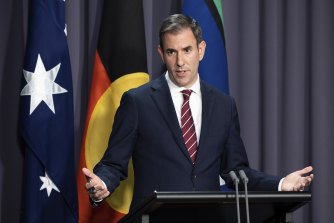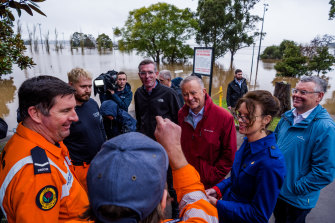Treasury to model economic impact of climate change after 9-year break
The federal Treasury is modelling the impact of climate change on the Australian economy and the national budget, re-starting work abandoned for almost a decade.
The Age and The Sydney Morning Herald can reveal Treasurer Jim Chalmers has directed his department to examine the cost to Australia from climate change as part of a broader effort to understand the risks facing businesses, households and key institutions.
Treasurer Jim Chalmers.Credit:Alex Ellinghausen
In October last year, Treasury secretary Steven Kennedy confirmed it had been “years” since the department had been asked to provide climate change modelling. Prior to 2013, Treasury was heavily involved in the modelling of climate change’s impact on the Australian economy.
Those revelations prompted Labor to commit to modelling the impact of climate change on the budget and economy. It also promised to feed those findings into the intergenerational report.
Chalmers on Wednesday confirmed his department was already starting work on rebuilding its ability to model the impact of climate change.
He said the nation’s economic prospects would in large part depend on the ability to take “ambitious action” on climate change while delivering cheaper and cleaner energy.
“Labor committed to restoring Treasury’s role in modelling climate risks and opportunities for the Australian economy, and this work is already under way,” he said.
“Treasury is working closely with other departments to rebuild this capacity after years of neglect under the Coalition, and we’ll have more to say about this important work.
“Treasury’s modelling will help us chart a path that maximises jobs and opportunities for our country as we take advantage of this transformation.”
Treasury involvement in climate change policymaking diminished quickly after the election of the Abbott government in 2013.
Last year’s modelling of the Coalition’s “Australian Way” policy, which examined the plan’s ability to reach net zero by 2050, was a composition of some traditional economic modelling and “bottom-up” research by consultancy McKinsey based on its own database of low-emission technologies.
The modelling was not carried out by Treasury and it also failed to consider the broader economic and budget costs of climate change in general.
Prime Minister Anthony Albanese, touring flood-affected parts of Sydney on Wednesday, said while Australia had always suffered from natural events such as floods and bushfires, they were now occurring more frequently and with greater intensity.
“We need to act on climate change, we’ve been saying that for a long period of time. We need to make sure as well that we’re a part of global action because one thing that is true is Australia acting alone won’t be enough,” he said.
Australian Prime Minister Anthony Albanese meets with SAS volunteers in Richmond, which has been severely affected by floods.Credit:James Brickwood
“We need to show leadership and encourage that action. And that is one of the reasons why my government is taking climate change seriously and engaging with the world to ensure that that global action steps up.”
Labor has committed to cut emissions by 43 per cent by 2030 and to hit net zero by 2050. It has a plan to tighten restrictions on the 215 biggest polluting facilities such as mines and smelters and to pump $20 billion into the electricity grid so it can take more renewable energy.
Leading think tank Climate Analytics found if the rest of the world followed Labor’s path, global warming would exceed 2 degrees.
A landmark report by University of Melbourne professor of environmental economics Tom Kompas, released in November, found this rate of global warming would cost Australia’s economy at least $584 billion by 2030 and $762 billion in 2050.
Kompas told The Age and The Sydney Morning Herald that modelling would enable the government to understand the cost of climate change and compare it to the earnings from polluting industries and provide Labor the opportunity to mount “an argument for being more proactive” on emissions reduction.
“The costs are lost in agricultural and labour productivity from heat stress. It’s pollution. It’s in biodiversity loss. It’s sea level rise and storm surge. It’s bushfires. It’s floods,” he said.
“When you think about all the potential costs that could be in fact avoided, given proper policy, it’s huge.”
Professor Kompas in May last year estimated the national cost of emissions reduction, achieved with either a carbon price or binding renewable energy target, would be $36 billion up to 2030, which he called a “negligible impact” of 0.14 per cent of GDP.
Deloitte Access Economics lead partner Pradeep Philip said the failure to model the cost of climate change during the past decade was Australia’s “great missed opportunity” and it was now “imperative” that government understood the costs.
“It’s important to understand that climate change is the single largest investment need in the economy because it affects every region and every sector. No one is immune from this.”
Cut through the noise of federal politics with news, views and expert analysis from Jacqueline Maley. Subscribers can sign up to our weekly Inside Politics newsletter here.
Most Viewed in Politics
From our partners
Source: Read Full Article

